Chatbots
101
by V-Soft Consulting
Chatbots 101 | V-Soft Consulting�
Chatbots are all the rage. They exist
for social media, websites, stores, and
even business to business conversations.
Chances are you’ve spoken to one, but
may not have even realized it. Chatbots
are taking over the Internet, saving
companies hundreds of hours and
manpower. In this eBook we will explore
the world of chatbots, how they came to
be, and what they are capable of.
Chatbots 101 | V-Soft Consulting�
Table of Contents
» What is a Chatbot?
» The History of Chatbots
» How Do Chatbots Work?
» How Can Chatbots Help Businesses?
» About the Author
Chatbots 101 | V-Soft Consulting�
What is a Chatbot?
To put it simply, chatbots are computer applications powered by
artificial intelligence to communicate with you. They are designed
to mimic natural human conversation via an online chat interface,
SMS, and sometimes, even voice chat. Despite being designed for
human consumption, chatbots are also capable of communicating
and gathering information from other chatbots.
There are many different names for chatbots: chatterbots,
talkbots, bots, chatterboxes, artificial conversation entities (ACE),
and virtual assistants. They are available for dozens of tasks, such
as helping answer any legal questions you may have, being a
personal therapist, or helping you keep your calendar organized.
There are also some as useless as the one designed to represent
a popular seasonal drink from your favorite coffee shop.
Most chatbots are preset to understand a specific range of
keywords and respond with the correct input. It’s more of a
complex “If this, then that” situation – if the user mentions
“e-mail setup”, then send user “how to set up your e-mail guide”.
However, there are some that are much more complex and
actually learn from conversations they have with other users.
What is Artificial Intelligence?
Much like how it sounds, artificial intelligence is when a
computer simulates humanlike intelligence. For a computer to be
considered intelligent, it must be capable of learning, reasoning,
recognition, and correcting errors. It is not, however, the
Hollywood interpretation of robots that are virtually human (Such
as Marvin the Paranoid Android from Hitchhiker’s Guide to the
Galaxy or C-3PO from Star Wars). That is still purely science fiction
and we are quite a long way off; it’s very likely to not happen
within our lifetime.
1
Chatbots 101 | V-Soft Consulting�
In order for a machine to act or behave like a human, they require
a great deal of information about many different situations, items,
categories, and relations for them to connect each occurrence to
one another in a method that is called knowledge engineering.
It includes groups of complex information compiled into a
knowledge base and linked through building, maintaining, and
using the information.
Types of Artificial Intelligence
There are many different categorizations of artificial intelligence,
but some of the most well-known are:
» Strong AI: Strong AI is when the machine involved is
developed to simulate human behavior and cognitive
abilities, as well as the ability to reason and learn. This
is what people typically think of when they think of AI:
robots that can respond to questions, solve problems, or
perform complex tasks. This type of AI is adaptive and has
opportunities to expand.
» Weak AI: Weak AI is when a machine is designed to carry
out a specific task – such as working an assembly line, or
playing chess against a master chess player. It is incapable
of self-improvement, so it will only be good at what it’s
programmed to do, nothing more.
Machine Learning
Machine Learning is a form of artificial intelligence that provides
machines the capability to learn and understand concepts
without being programmed specifically for that purpose. It utilizes
things like Deep Learning – essentially, predictive analytics – and
different algorithms for data to be logged and input into the
device’s knowledge base.
2
Chatbots 101 | V-Soft Consulting�
Machine learning algorithms are typically classified into three
broad categories, depending on the information available to the
machine in question. These are:
» Supervised Learning: Where data is essentially labeled and
described to the machine in order for it to detect and sort
the new information.
» Unsupervised Learning: Information is not specified or
labeled in any way, but may be sorted in reference to their
similarities or differences.
» Reinforcement Learning: The machine is given a specific
goal to follow through with, followed by a review and
providing feedback, whether positive or negative.
Natural Language Processing
Natural Language Processing is where a machine is capable of
understanding the way a human speaks naturally. This is a very
complex and challenging task for computers to comprehend, as
they are very precise whereas human speech is not. Things like
slang, metaphors, contractions, and other variables can result in
the machine not correctly understanding requests.
Natural Language Processing (NLP) utilizes machine learning and
other forms of artificial intelligence to “learn” the way their users
speak, using assessments to correctly identify the user’s request.
It requires a considerable amount of programming, analytics,
the understanding of semantics and syntax, segmentation, and
tagging to function as expected.
Consider this: you’re hungry and have a craving for duck. You
message a local chatbot and ask for “good places with duck” – the
bot quickly churns out several restaurants in your area that have
duck on the menu. This would not be possible without Natural
Language Processing (You’d likely get a confused bot that wouldn’t
be able to process your request).
3
Chatbots 101 | V-Soft Consulting�
In fact, chances are you’ve already used Natural Language
Processing today. Things like Google’s predictive searches, your
phone’s auto correct/auto complete, or even spam detectors
utilize Natural Language Processing.
The Turing Test
The Turing Test was developed by an English computer scientist
by the name of Alan Turing in 1950. It is a controversial test
designed to test the ability of a machine to exhibit intelligent,
humanlike behavior. To pass the test, the machine’s replies would
have to be indistinguishable from a human in a five-minute test.
Turing predicted that by the year 2000, machines would be able
to fool 30% of human judges, but this feat took much longer than
anticipated. As of 2017 no machines have truly passed the Turing
Test, but there have been claims that a chatterbot by the name of
Eugene Goostman passed the test in 2014 by fooling 33% of the
judges involved into believing he was a human being.
The test was not intended to test a machine’s intelligence,
only that a machine behaves and acts like a human being would
when faced with the same situations. As not all human behavior is
intelligent, the Turing Test would also test for behaviors like lying,
making typing mistakes, or responding to insults. Another reason
that intelligence is omitted from the test is that machines are far
more likely to solve complex mathematical problems that would
be impossible (or nearly impossible) for a human to solve.
The History of Chatbots
The idea of creating a machine that had humanlike thought
processes has been around for centuries. Scientists, philosophers,
and even sculptors were fascinated by the idea of a humanistic
automaton capable of thought.
4
Chatbots 101 | V-Soft Consulting�
Author Samuel Butler first wrote the idea of a mechanical
consciousness in his 1872 science fiction novel, Erewhon. Despite
the interest and fascination on the subject, it was not until 1966
when any form of artificial intelligence really took form: ELIZA.
ELIZA
Generally recognized as the first actual chatbot, ELIZA was developed
by Joseph Weizenbaum. Named after Eliza Doolittle, a working-
class character in the play Pygmalion, ELIZA was meant to emulate
a Rogerian psychotherapist. It was capable of answering basic
questions and asking for users to elaborate on their discussions.
For example, if you told ELIZA that you were sad, it would respond
with “Why are you sad?” inciting a further discussion and urging you
to continue. Unfortunately, the program was not more involved
than this, unable to understand the conversations it was having.
ELIZA was a groundbreaking invention despite its lack of “real”
intelligence. Despite only being capable of using pattern
matching and substitution methodology to form new sentences,
ELIZA would receive an overwhelming response of positivity for
its “human-like” conversations; even Weizenbaum’s secretary was
taken by the program. It inspired dozens of other chatbots both
serious and comedic.
A.L.I.C.E.
One of the chatbots inspired by ELIZA was A.L.I.C.E (Artificial
Linguistic Internet Computer Entity), also known as Alicebot.
Alicebot was the brainchild of robotics professor Richard
Wallace, officially going live in 1995. Alicebot uses AIML (Artificial
Intelligence Markup Language), a programming language that
describes a class of data objects (called AIML objects) and partially
describes the behavior of computer programs that process them.
Essentially, it will have a list of categories to discuss with the user
– most bots have around 45,000 different topics to choose from –
and choose the most “accurate” response for the discussion.
5
Chatbots 101 | V-Soft Consulting�

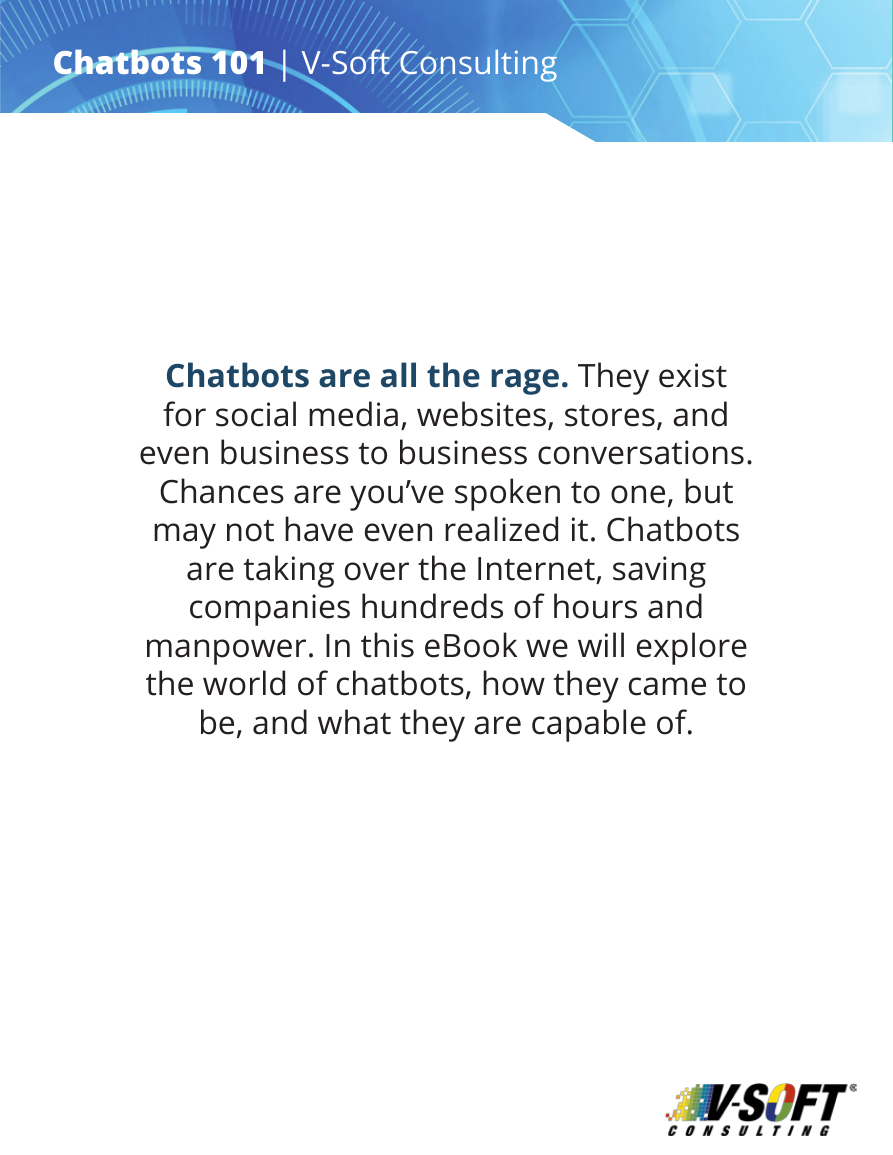
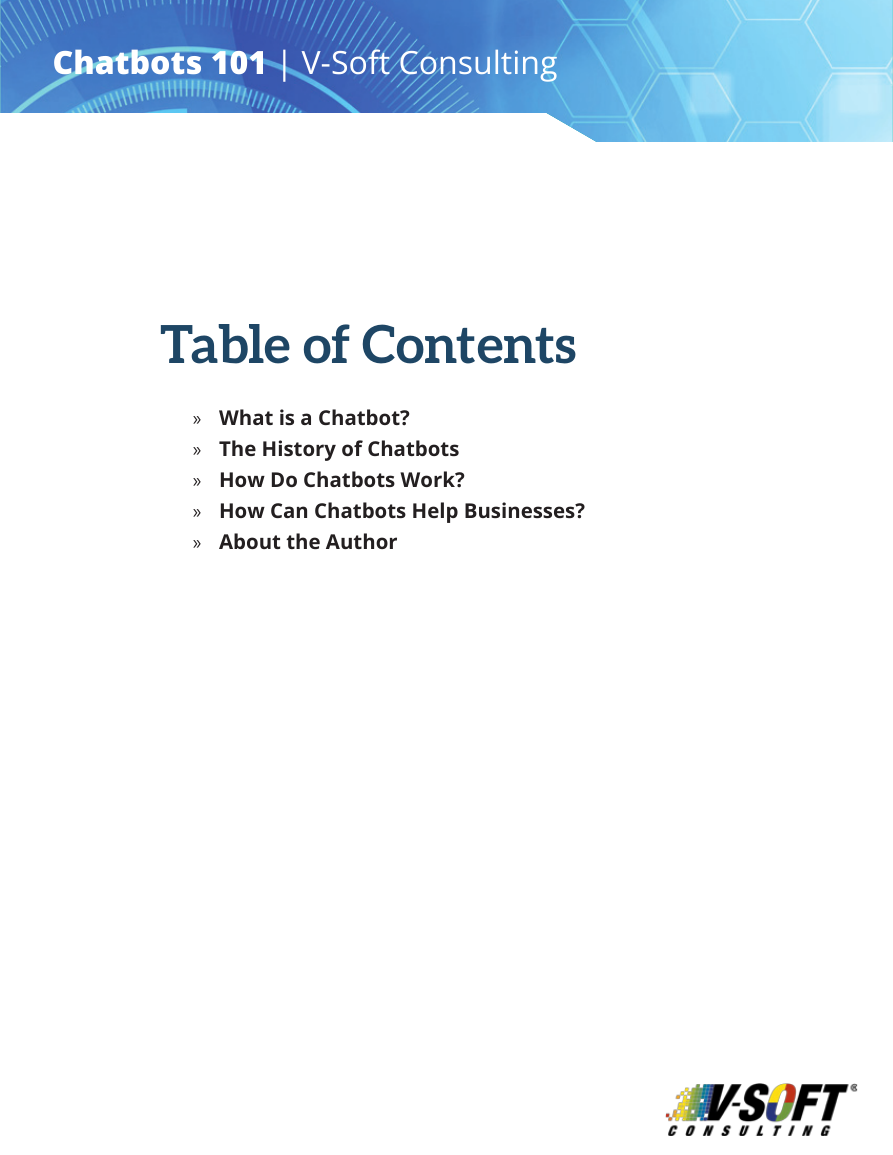
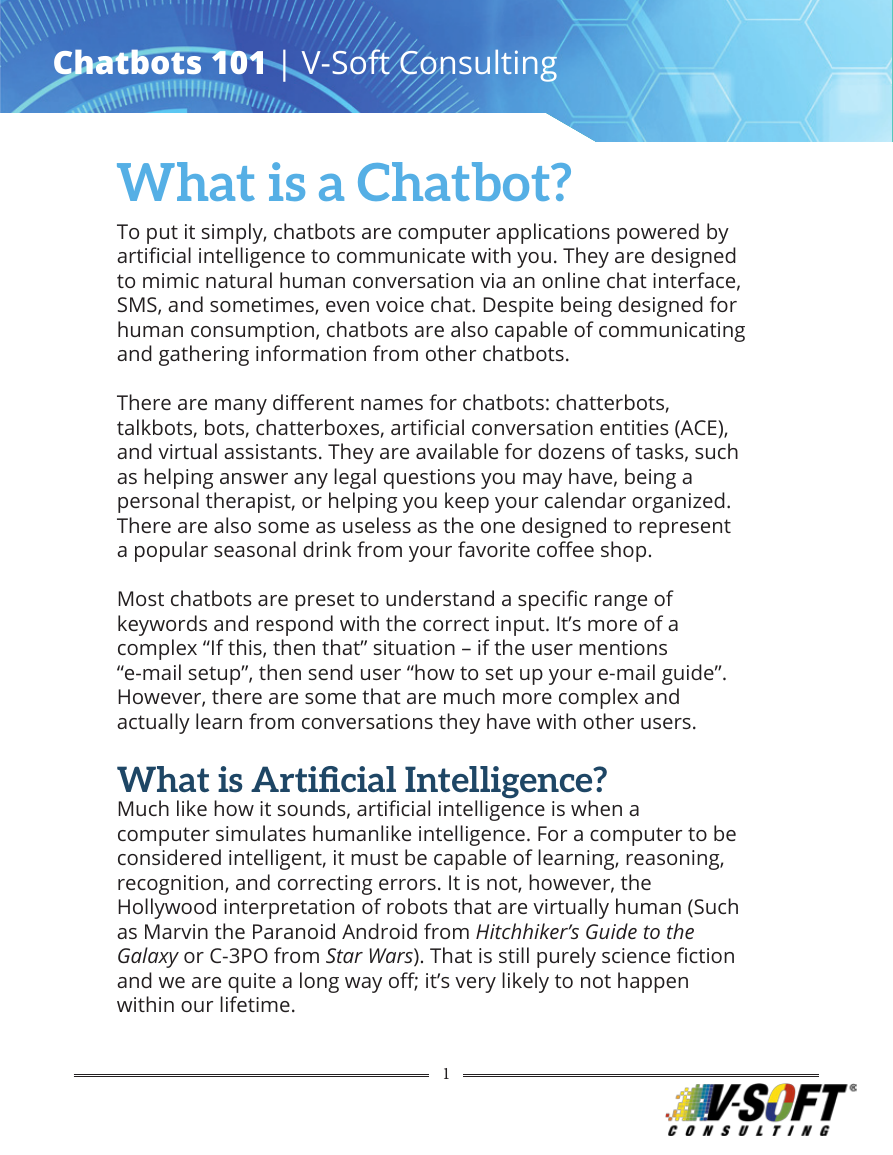
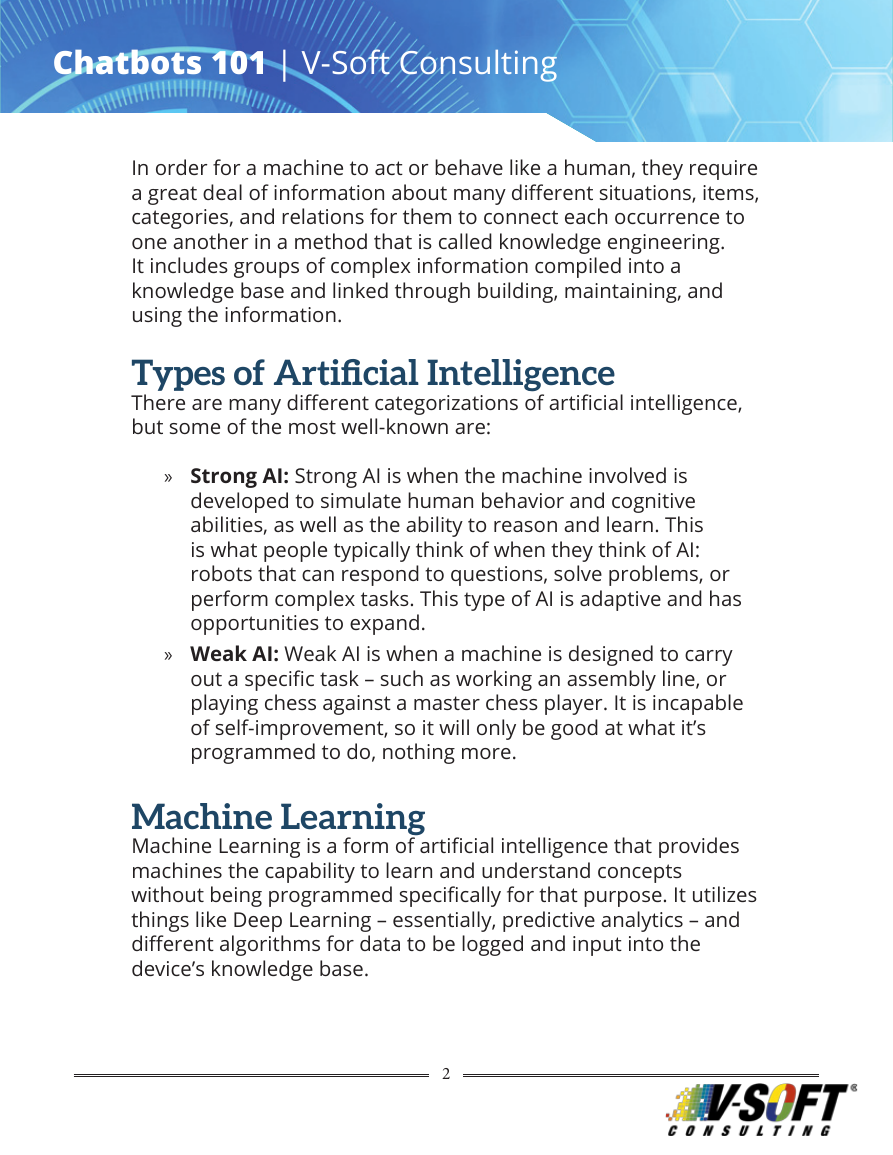
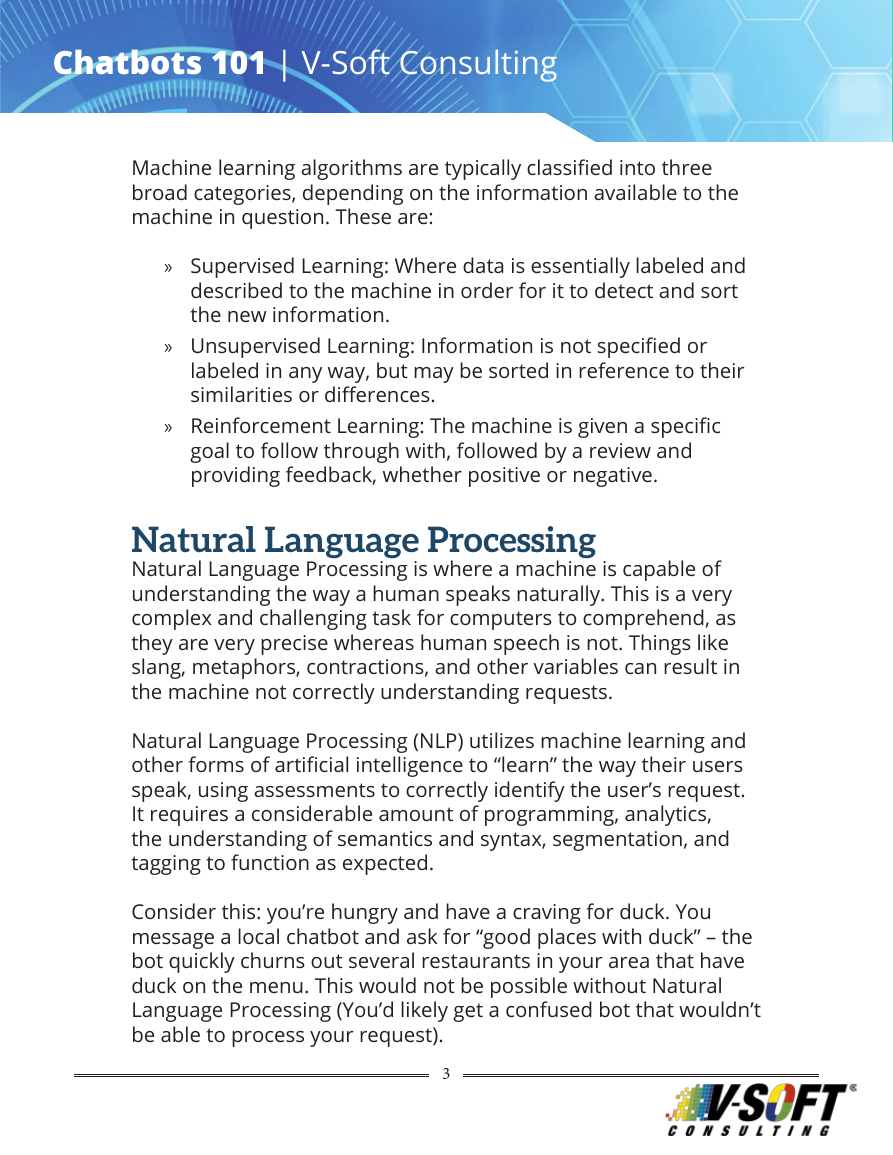
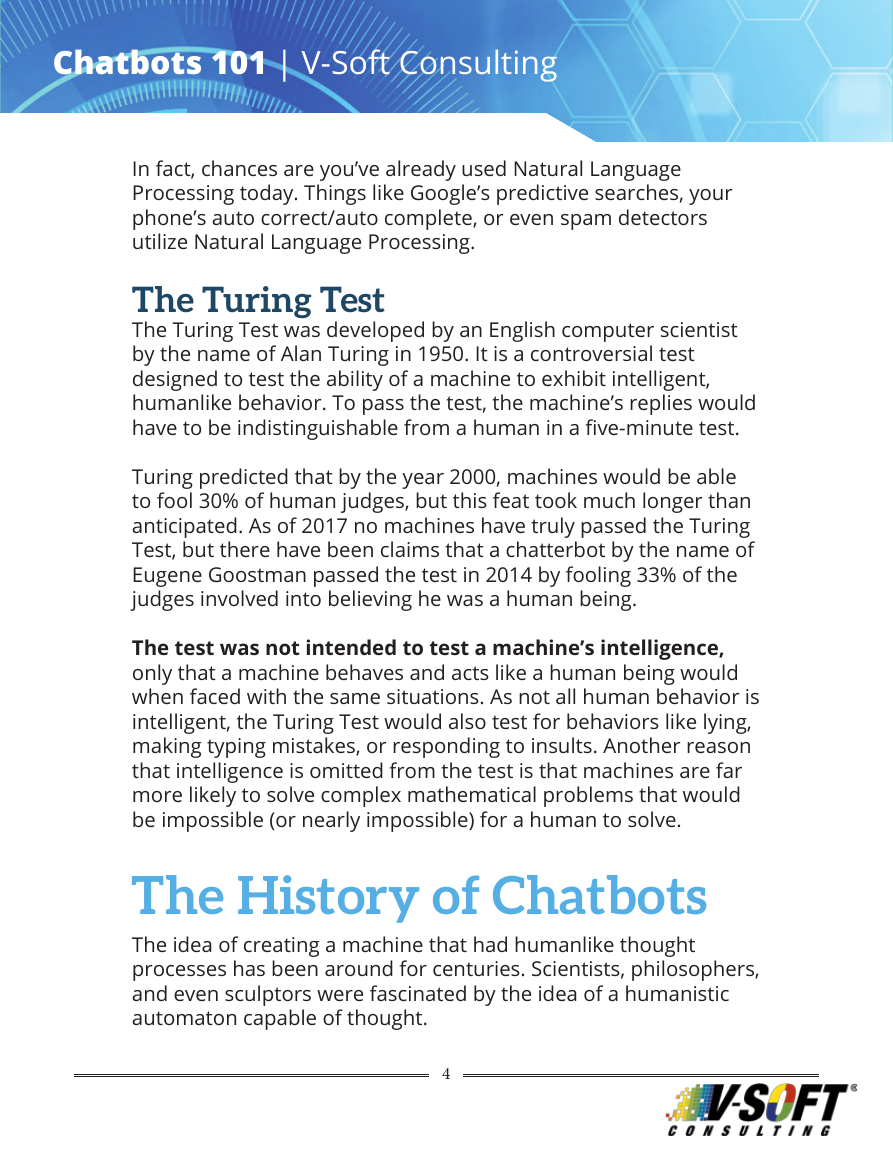
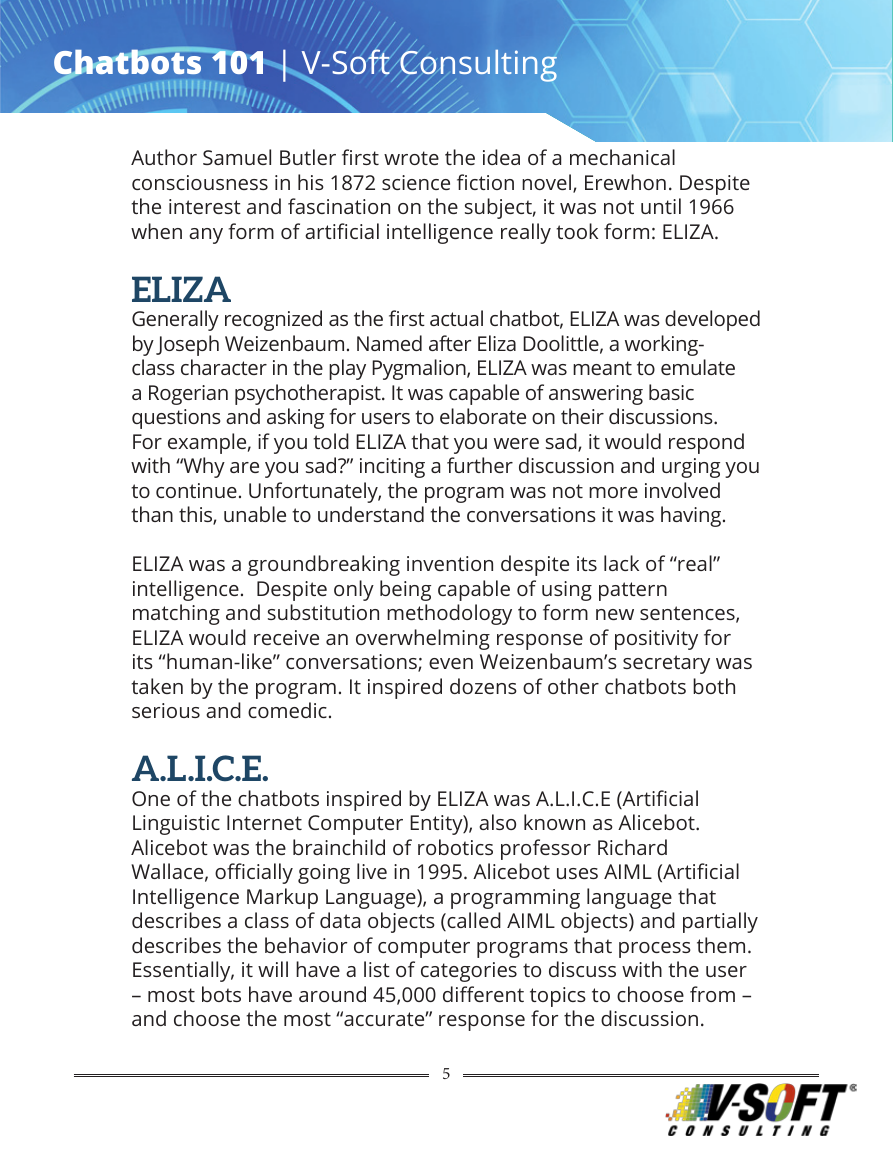








 2023年江西萍乡中考道德与法治真题及答案.doc
2023年江西萍乡中考道德与法治真题及答案.doc 2012年重庆南川中考生物真题及答案.doc
2012年重庆南川中考生物真题及答案.doc 2013年江西师范大学地理学综合及文艺理论基础考研真题.doc
2013年江西师范大学地理学综合及文艺理论基础考研真题.doc 2020年四川甘孜小升初语文真题及答案I卷.doc
2020年四川甘孜小升初语文真题及答案I卷.doc 2020年注册岩土工程师专业基础考试真题及答案.doc
2020年注册岩土工程师专业基础考试真题及答案.doc 2023-2024学年福建省厦门市九年级上学期数学月考试题及答案.doc
2023-2024学年福建省厦门市九年级上学期数学月考试题及答案.doc 2021-2022学年辽宁省沈阳市大东区九年级上学期语文期末试题及答案.doc
2021-2022学年辽宁省沈阳市大东区九年级上学期语文期末试题及答案.doc 2022-2023学年北京东城区初三第一学期物理期末试卷及答案.doc
2022-2023学年北京东城区初三第一学期物理期末试卷及答案.doc 2018上半年江西教师资格初中地理学科知识与教学能力真题及答案.doc
2018上半年江西教师资格初中地理学科知识与教学能力真题及答案.doc 2012年河北国家公务员申论考试真题及答案-省级.doc
2012年河北国家公务员申论考试真题及答案-省级.doc 2020-2021学年江苏省扬州市江都区邵樊片九年级上学期数学第一次质量检测试题及答案.doc
2020-2021学年江苏省扬州市江都区邵樊片九年级上学期数学第一次质量检测试题及答案.doc 2022下半年黑龙江教师资格证中学综合素质真题及答案.doc
2022下半年黑龙江教师资格证中学综合素质真题及答案.doc